Strafe Cham Jacket & Pants
Test Locations: Crested Butte Backcountry & Mt. Sneffels, CO
Days Tested: ~13
Reviewer: 5’8”, 155 Ibs / 173 cm, 70 kg
Size Tested: Medium (unisex)
Blister’s Measured Weight (size Medium):
- Cham Jacket: 459 g / 16.2 oz
- Cham Pant: 461 g / 16.3 oz
Materials:
- Main Fabric: 40Dx20D 3L Schoeller Aerobrane laminate
- Pant Cuff Reinforcements: Cordura nylon
Jacket Features:
- underarm vents
- helmet-compatible hood with 3-point adjustment
- microfleece-lined front hood & chin guard
- water-resistant YKK AquaGuard® (Coil) and VISLON® zippers.
Pant Features:
- hamstring vents
- built-in belt with webbing & hook
- extra tall CORDURA® scuff guards and adjustable with YKK snaps at back calf.
- boot compatible with single pull drawcord at hem and powder cuffs to keep snow out.
Jacket Pockets:
- 2 exterior chest (zippered)
- 1 exterior forearm (zippered)
- 1 interior drop-in
- 1 interior chest (zippered)
Pant Pockets:
- 2 exterior hand (zippered)
- 1 mesh sleeve inside right hand pocket
MSRP:
- Cham Jacket: $549
- Cham Pant: $469

Intro
Since its introduction several years ago, the Cham kit has always served as Strafe’s most breathable, touring-oriented, 3-layer shell. It’s also gone through several changes throughout its existence, as Strafe experimented with a few different fabric options in an effort to get the ideal balance of breathability, weather resistance, and comfort.
That’s once again the case for the 2020-2021 season, with the updated Cham kit featuring a new, air-permeable fabric from Schoeller that’s dubbed “Aerobrane.”
Our other reviewers have all been fans of prior iterations of the Cham kit due to the (various) fabrics offering above-average breathability and useful weather resistance, the kit’s minimal-yet-functional feature set, and its more relaxed fit that you rarely find in technical, breathable shells.

I got the new Cham Jacket and Pant this past spring and used them for a few late-spring ski missions, various alpine outings throughout the summer, and also some very early season touring days this fall.
Overall, I’ve come away extremely impressed. We gave the Cham kit our “Best Of” award in our 20/21 Winter Buyer’s Guide, and here I’ll go into (much) more detail on why I think this kit truly stands out amidst a very crowded category of backcountry shells.
Fit
Strafe says the 20/21 Cham Jacket and Pant have a unisex fit and come in what I’d call “versatile” colorways to match.
For reference, I’m 5’8”, 155 Ibs / 173 cm, 70 kg and tend to get along well with a men’s size Medium in most apparel.
The size Medium Cham Jacket and Pant fit me quite well overall, and I’d say the fit hasn’t changed a whole lot compared to the previous versions of the Cham kit. The new Cham still features a fairly roomy cut, particularly compared to minimalist, touring-oriented pieces like the Black Diamond Helio Active Shell, Norrona Lyngen Hybrid, and (to a slightly lesser degree) the new Patagonia Stormstride.
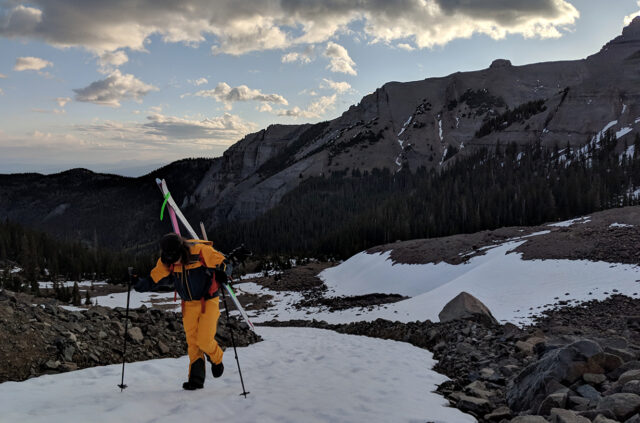
I really like the fit of the Cham. It leaves me plenty of room for layers underneath and never gets in the way while doing yoga-esque maneuvers on the ascent, yet isn’t so relaxed that I think it looks or feels excessively baggy. Particularly for (vain) people like me who aren’t fans of the skin-tight look for subjective aesthetic reasons, the Cham’s fit makes it stand out from a lot of the other options that rival its breathability (more on that later). If you prefer a very slim fit, the Cham isn’t the best choice for you, but I do think its fit will work for a lot of folks.
The Cham Pant features a couple of fit-adjustment features, including a built-in belt that’s really clean and pretty functional. It consists of a flat, aluminum hook that you can slot into various sewn-in loops on the other side, and this sleek, simple design means that I’ve never noticed it when I’m wearing a harness or pack.
While I think that this belt will work really well for a lot of folks, unfortunately, I wasn’t able to get quite as tight of a fit as I would like (which is sometimes the case with men’s Medium pants for me). I measured the waist of the size Medium Cham Pant and it’s around 36” when the belt isn’t tightened, which is big for a size Medium, though it’s about 32.5” with the belt set at the tightest setting. That’s a broad range of adjustment, but I typically wear pants with a 31” waist, so it still felt a bit big.
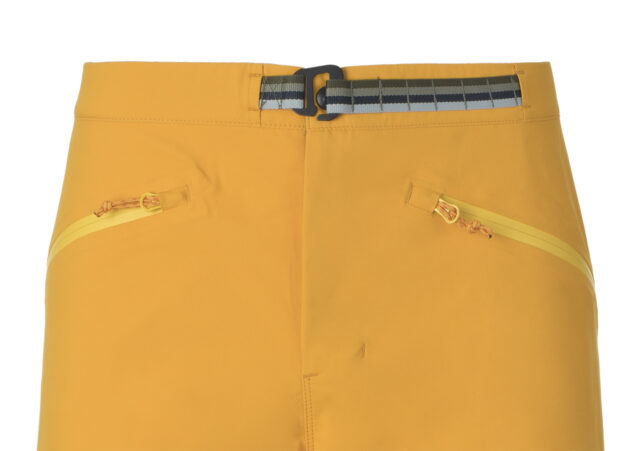
The Cham Pant does not come with belt loops, which I like to have on pretty much all pants and shorts because, hey, someday I might actually stop downing donuts and cheese curds, and it’s nice to be able to fully customize the fit. But as someone with a bit of sewing experience, I’ll probably just sew on another webbing slot to the Cham Pant’s waist to get a tighter fit. All that said, I’d recommend trying on the Cham Pant before buying, and size down if you’re often between sizes since I’d say it runs a bit large.
The other fit-adjustment feature is a set of snaps on the backside of each leg. These let you tighten up the cuff area of the Cham Pant, and they do work quite well. Since the Cham Pant’s fit is on the looser side, those snaps are really useful on technical ascents when you’ve got pointy, stabby things on your feet. I used those snaps during an attempt on Mt Sneffel’s Snake Couloir and they worked great — I never caught my crampons on the Cham Pant’s fabric. I did notice that they had un-snapped a couple of times throughout the day, but I still didn’t manage to snag the fabric. If you’re seeking a pair of pants that will primarily be used with crampons, I think it’d make sense to go with something slimmer. But as someone who spends most of the year with my boots attached to bindings and not crampons, I think the Cham Pant’s roomy fit + cuff snaps offer a nice, functional compromise.
Overall, the fit of the Cham kit reminds me of the old Patagonia Descensionist, though the Cham Pant is a bit slimmer through the lower leg and the Cham Jacket doesn’t feel quite as roomy through the torso. Compared to the new Patagonia Stormstride kit, the Cham kit is a bit roomier throughout.
For reference, the size Medium Cham Jacket I have has a front-zipper length of about 73 cm / 29 in, with the back-center length being about 6 cm / 2.5 in longer than the front. My size Medium Cham Pant has an inseam that’s roughly 81 cm / 32 in, though the pant’s gusseted crotch makes that number a bit harder to accurately measure.
Features
One thing that’s remained pretty consistent across pretty much all the iterations of the Cham kit is its feature set. And I am very happy about that, because this kit’s feature set is just about perfect for my preferences: everything I want, with almost nothing I don’t need.
The Cham Jacket has a helmet-compatible hood that works pretty well when you’re not wearing a helmet, and quite well when you are. I mostly use its rear adjustment to keep it snug on my head, but there are also adjustments on either side of the collar for really battening down the hatches in poor weather. The Cham Jacket also has dual cordlocks at the hem for cinching that down, and all the cords are kept pretty tidy inside the jacket (nothing slapping you in the face or crotch while skiing fast downhill). It does not have a powder skirt, which is great for me since I basically never use them, but worth noting if you’re a powder-skirt fan.
The Cham jacket also has Velcro-style cuff adjustments that have stayed closed (even in heavy snow) and make it work well with everything from bare hands to fairly bulky mittens.
Apart from the aforementioned built-in belt and snaps near the cuffs, the Cham Pant comes with interior “powder gaiters” that have done a great job of keeping out snow while still working with all of my touring and alpine boots (something that can’t be said of some of the slimmer, touring-specific pants I’ve used).
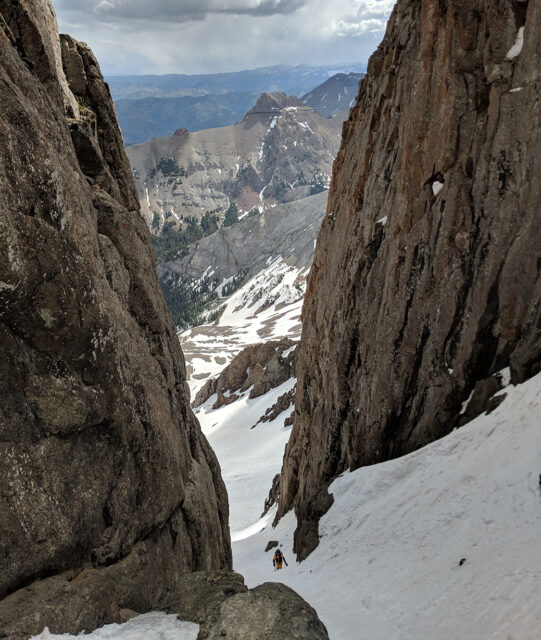
The Cham pant’s outer fabric at the cuff also has a cordlock for further tightening the cuffs around my boots or shoes, which was helpful when the approach to the snow involved a lot of hiking on trails where low-profile hiking shoes were more appropriate than ski boots.
Speaking of the pant’s cuffs, they have a generously sized patch of burly Cordura fabric along the inside of the leg. While many touring-oriented pants skimp on this feature, the Cham Pant gives you a broad area of protection from ski edges and crampons, with its Cordura patches extending about 29 cm / 11.5 in up the leg and wrapping about 25.5 cm / 10 in around the base of the cuff. I’m happy to deal with a few more grams in exchange for a more durable and functional pant, so I love the Cham Pant’s cuffs.
Both the Cham Jacket and Cham Pant feature pretty big vents. Up top, you get 45 cm / 17.7 in underarm vents, and down low you get 32.5 cm / 12.75 in vents on the backside of each leg. Both sets of vents are unlined, which means they open up really wide, allow for a lot of airflow, but will also let in some snow if you forget to close them for the descent.
Pockets
My favorite part about the Cham Jacket’s feature set is its two, huge exterior chest pockets. They’re about 28 cm / 11 in long, 18.5 cm / 7.25 in wide, and big enough to fit just about any pair of climbing skins I have. And since they’re chest pockets, I can access them while wearing a pack and / or harness. I like chest pockets, and I especially like the Cham’s chest pockets.
The Cham Jacket’s left exterior chest pocket also has an interior mesh sleeve that’s great for keeping a phone or similarly sized object secure and not bouncing around within the otherwise very spacious pocket.
The Cham Jacket doesn’t have handwarmer pockets, which is fine by me for a touring shell cause I basically never use them in the backcountry. Your mileage may vary. On the Cham’s left forearm, there’s a small zippered pocket that’s nice for a goggle wipe, lip balm, or other small things. It doesn’t really get in the way or feel weird, though it’s probably the only feature I could do without on the Cham Jacket.
Inside, the Cham Jacket has a mesh drop-in pocket and a zippered chest pocket. The drop-in pocket is great for gloves or other things you need to dry out. I stashed a pair of soaking-wet gloves in there and after about a half an hour of working hard on the skin track, they were basically dry. That’s one of the less obvious upsides of having a shell that’s very breathable — you can actually use your body heat to help dry your stuff, rather than having the interior of the shell basically be a humid steam room. And then the interior chest pocket is also nice for a phone (my iPhone 6 fits easily, with about an inch to spare length- and width-wise).
The Cham Pant has two hand pockets, both of which are quite large and would likely fit most skins. Inside the right hand pocket is a stretchy mesh sleeve and a sewn-in loop that’d work with most beacons, if you’re someone who prefers to keep your beacon in your pants.
Weight & Packability
Strafe markets the Cham kit as “ultralight,” and they have good reason to. The Cham Jacket and Cham Pant are some of the lightest snowsports-oriented shells we’ve reviewed.
The Cham Jacket and Pant are both about the size of a 32-oz Nalgene water bottle or cantaloupe when you really scrunch them down / roll them up. While I rarely feel the need to take it off, the Cham Jacket packs down smaller than the majority of shells I’ve used, which is a plus when trying to keep the size of my pack to a minimum.
For reference, here’s a list of some of the other jackets and pants we’ve reviewed, and their respective weights. Note that not all of the pieces are the same size, so try to keep that in mind when making comparisons.
Jackets:
364 g Black Diamond Helio Active Shell, size Medium
366 g Patagonia Ascensionist Jacket, size Medium
435 g Arc’teryx Rush LT Jacket, size Medium
459 g Strafe Cham Jacket, size Medium
464 g Houdini Shelter Anorak, size Medium
518 g Flylow Cooper Jacket, size Medium
544 g Outdoor Research Hemispheres Jacket, size Medium
563 g Rab Sharp Edge Jacket, size Medium
571 g TREW Capow Jacket, size Medium
574 g Amundsen Peak Anorak, size Medium
590 g Flylow Higgins Coat 2.1, size Large
593 g Patagonia PowSlayer Jacket, size Large
598 g The North Face Freethinker Jacket, size Medium
601 g Spyder Sanction GTX Pro Shell Jacket, size Medium
605 g Patagonia Descensionist Jacket, size Medium
610 g Strafe Cham Jacket, size Large
615 g Patagonia SnowDrifter Jacket, size Medium
626 g Arc’teryx Sabre LT Jacket, size Medium
635 g Mammut Alvier Armor Hardshell Jacket, size Medium
665 g Norrona Tamok Gore-Tex Pro Jacket, size Medium
701 g Eddie Bauer BC Freshline Jacket, size Medium
726 g Holden M-51 Fishtail 3 Layer Jacket, size Medium
740 g Black Diamond Mission Ski Shell, size Medium
825 g The North Face Ceptor Jacket, size Medium
841 g Strafe Pyramid Jacket, size Large
848 g Open Wear Open One 3L Shell Jacket, size Medium
1047 g FW Manifest 3L Jacket, size Large
Pants:
441 g Norrona Lyngen Windstopper Hybrid Pants, size Large
461 g Strafe Cham Pants, size Medium
485 g Strafe Cham Pants, size Large
494 g Patagonia Descensionist Pants, size Medium
539 g Arc’teryx Rush LT Pant, size Medium
555 g Open Wear Open One 3L Shell Pants, size Medium
603 g Patagonia PowSlayer Bibs, size Large
608 g Patagonia SnowDrifter Bibs, size Medium
618 g Rab Sharp Edge Pants, size Medium
620 g Arc’teryx Sabre Pants, size Large
635 g Spyder Turret GTX Shell Pants, size Medium
638 g The North Face Freethinker Pants, size Medium
723 g Black Diamond Mission Pants, size Medium
775 g FW Manifest 3L Pants, size Large
824 g TREW Capow Bib, size Medium
896 g Flylow Baker Bib, size Small
Materials
Alright, now onto what is the proverbial “meat and potatoes” of any outerwear review: the materials.
The Cham Jacket and Pant both use a fabric from Swiss textile manufacturer, Schoeller. In the Cham kit, it consists of a 3-layer laminate with a 40-denier x 20-denier stretch-ripstop face fabric, a soft knit backer, and Schoeller’s new Aerobrane membrane.
Aerobrane is a new membrane and the Cham kit is one of the first to use it, so detailed information on it is a bit limited right now. Schoeller says that it’s an air-permeable, electrospun membrane, and those two factors put it in line with The North Face’s Futurelight membrane — at least on paper.
(If all that sounded like a foreign language or you just want to learn more about outerwear fabrics, check out our Outerwear 101 and Outerwear 201 articles.)
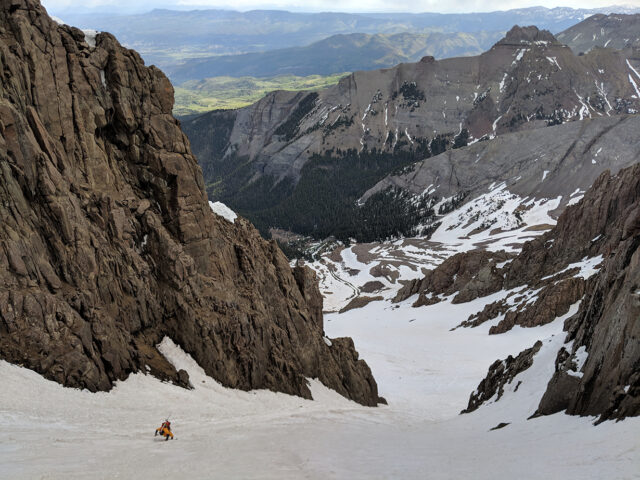
I’ll get into the performance characteristics of this laminate below, but in terms of hand feel, structure, and drape, I really like the Cham’s fabric. It is extremely supple and comfortable on skin, feeling similar to the Patagonia Descensionist, Patagonia Snowdrifter, Houdini Rollercoaster, and Houdini Shelter in those regards. The Cham does not feel like a typical “hardshell” like most Gore-Tex fabrics — the Cham is not stiff or crinkly.
The Cham’s fabric is quite light, and combined with its supple structure, it wouldn’t be my top pick if you’re prone to getting up close and personal with things like trees, rocks, etc. But for a touring shell, I love the Cham fabric’s combination of low weight, comfortable hand feel, and stretch.
Weather Resistance
We don’t have water-resistance stats for the Cham’s Schoeller Aerobrane fabric, but in my experience so far, it’s proven to be very weather resistant.
I’m planning on using this kit a whole lot more throughout the coming season and will update this review with any new impressions. But after several outings in wet snow and a few hours in a full-on downpour, I haven’t had any water get all the way through the Cham’s fabric. The face fabric eventually absorbed some water after about 20 minutes in really heavy rain, but I couldn’t find any areas where the water had actually gotten through the membrane and inside the jacket.
Now, purely based on my experience with similarly breathable shells, the Cham would not be my top pick for extremely wet environments like the US Pacific Northwest. After using a lot of different shells with a lot of different fabrics, I’ve found that you still generally need to make some tradeoffs when it comes to breathability and water resistance. And given just how well the Cham’s fabric breathes, I suspect that it would not fend off continuous exposure to water as well as less breathable fabrics like Gore-Tex Pro and Gore-Tex Active.
But for a place like Colorado, where our snow is generally fairly light and dry, I don’t foresee any ski-touring scenarios where I’d need more water resistance than the Cham has so far provided.
In short, of the numerous pieces I’ve used, the Cham kit offers the best combination of weather resistance and breathability for a touring-oriented outerwear kit for where I ski.
As for wind, like most air-permeable shells, the Cham blocks out enough wind to keep me comfortable, but I can feel just a tiny bit of air getting through during extremely intense gusts. And I don’t mean the “cutting” feeling you get while wearing, say, a fleece jacket or T-shirt in high winds. It’s more that, when wearing just a baselayer underneath the Cham, the inside of the Cham’s fabric feels a bit cooler when the wind is really blowing. If I’ve got a midlayer underneath the Cham, this is a non-issue.
Breathability
Compared to other shells that match its level of weather resistance, the Cham kit might be the most breathable one I’ve used.
My very first day in this kit was late in May, during a 10-hour, 13-mile day of hiking, climbing, and a little bit of skiing on Mt. Sneffels. The temperatures throughout the day ranged from around 25°F to 45°F (about -4°C to 7°C), the air was pretty dry / not humid, and I was wearing a 180 g/m2 wool bottom from Ridge Merino and Patagonia’s Capilene Cool hoody as my baselayer kit.
Throughout that entire day, I never felt the need to take off the Cham kit.
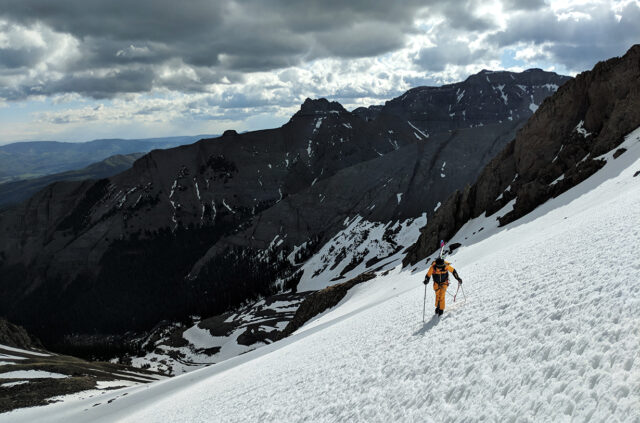
In those conditions and during that sort of activity, that’s something that I highly doubt I would’ve been able to do in just about any other waterproof outerwear kit. There were a couple of times during transitions where I got a bit colder than I’d have liked, but I think the same would’ve happened in just about any other shell, due to my minimal layering choices. And there were a couple of times (bootpacking in the sun) where I’m sure I would’ve been sweating a bit less if I took off the Cham Jacket. But overall, I was incredibly — and very surprisingly — comfortable wearing the Cham kit for the whole day.
In case you couldn’t tell, I was blown away by the breathability of the Cham kit after that first day. Since that outing, I’ve been able to use it in a wider range of conditions to get a better idea of where it fits in the market.
After using it in some more winter-like conditions (snowing, fairly humid, and just below freezing), it’s clear that the Cham kit still doesn’t match the breathability of most softshells that don’t have a membrane. Membrane-less shells like the excellent, old Strafe Recon still allow me to sweat a bit less in humid environments while working really hard. In terms of breathability, skinning or walking uphill in the Cham is definitely not the same as doing so in a baselayer or T-shirt.
But membrane-less softshells and baselayers also don’t match the Cham in terms of weather resistance, which is why I think the Cham makes for such an excellent touring kit. Unless it’s both above freezing and pretty humid, I think I’d be comfortable keeping the Cham kit on all day, which is something I can’t say for the vast majority of “waterproof” shells on the market.
For reference, the only 3-layer shells I’ve used that I think are similar to the Cham in terms of breathability are the old Patagonia Descensionist and the old Patagonia Knifeblade (the Knifeblade used Polartec’s PowerShield Pro fabric). I think PowerShield Pro still wins by a small margin in terms of breathability, but the fact that the difference isn’t massive is noteworthy in and of itself.
Outlier’s like those two Patagonia pieces aside, the Cham’s fabric is significantly more breathable than options like Gore-Tex Pro, regular Gore-Tex, any brand’s proprietary “20K/20K” fabric, and even Gore-Tex Active.
Unfortunately, I haven’t been able to use any of The North Face’s Futurelight pieces. Based on what fellow reviewer Sam Shaheen said about The North Face Freethinker Futurelight kit, I think the Cham is slightly more breathable than that kit, but we’re hoping to do a head-to-head comparison this season and will update if / when that happens.
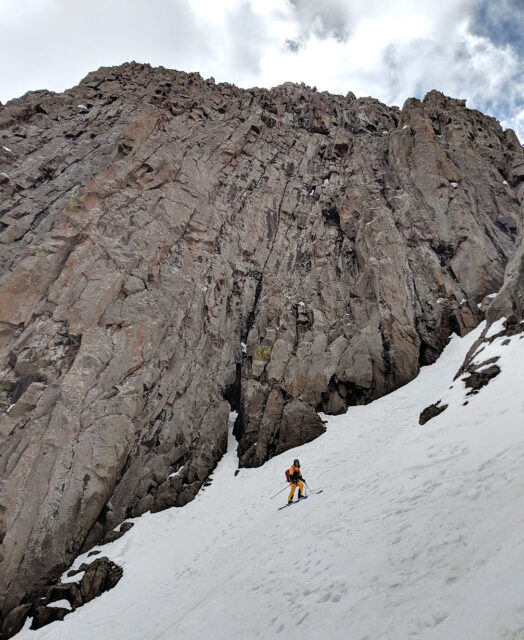
Another upside to the Cham’s breathability is that it dries really fast. Its thin, lightweight laminate helps with that, but the fact that my body heat can actually escape the shell’s fabric means that that heat can also help evaporate moisture on / in the fabric. While skinning during a pretty heavy snowstorm, I noticed that the Cham’s fabric felt surprisingly dry at the top of the skin track. After skinning for over an hour in heavy, wet snow, I’m sure the DWR finish had been “overwhelmed” and the Cham’s exterior face fabric had started to absorb some moisture. But the heat created from my body seemed to have caused that moisture to evaporate. This is something I’ve noticed with other ultra-breathable, 3-layer fabrics like Polartec PowerShield Pro, and I think it’s also what helped my wet gloves stashed inside the Cham’s interior pocket dry out so quickly.
On top of all that, the Cham Jacket and Pant also provide above-average ventilation options. When I decide to set a skin track that’s too steep or things just get extra hot and steamy, the Cham’s underarm and hamstring vents make it easy to dump a lot of heat.
The main point is that, if you’re someone who likes to keep your shell on during a whole day of ski touring and you need something more weather resistant than a softshell, the Cham kit is one of the best options we’ve used.
Warmth
The Cham is an uninsulated shell, so it offers very little insulative value on its own. But apart from the aforementioned scenarios where you’re only wearing a thin baselayer and in really windy conditions (where the Cham can feel a bit colder than other waterproof shells), I’d say the Cham is about average in terms of warmth compared to other shells. I’ve been totally comfortable using the same layering system with the Cham as I would with any other shell.
Durability
I have no issues to report so far, but it’s still important to keep in mind that the Cham Jacket and Pant are lightweight, breathable, touring-oriented pieces, not indestructible things designed to hold up to tons of wanton abrasion.
I haven’t been particularly careful with the Cham kit so far and it’s stood up to some bushwhacking and general disregard for its ultralight construction. But if you’re planning on using your outerwear kit for a pretty equal mix of frequent inbounds laps and backcountry tours or you’re just generally hard on your gear, you’ve got more durable, heavier options (e.g., Strafe’s Pyramid & Nomad, Patagonia’s SnowDrifter, Houdini’s Rollercoaster).
I’ll update this section if I run into any issues down the line, but as of right now, the Cham kit seems plenty burly for folks who prioritize low weight and breathability (and who recognize the tradeoffs that typically come with those traits).
Who’s It For?
Backcountry skiers and snowboarders who want a very weather-resistant shell kit that breathes notably better than the competition.
I would not recommend the Cham kit if you only ski via lifts or other mechanized access, and I think you’ve got better options if you spend a bit of your time earning your turns, but most of your time in the resort. Shells like the Strafe Nomad, Strafe Pyramid, Patagonia Snowdrifter, Houdini Rollercoaster, and Trew Capow are all better for that. And if most of your backcountry days involve really wet snow or rain, you might be better off going with something less breathable and more weather resistant (e.g., Patagonia Ascensionist, Norrona Lofoten, Patagonia Stormstride, Strafe Nomad).
But for those looking for an outerwear kit that will be primarily used on days that involve skinning, hiking, and / or climbing to get to the top of your descent, the Cham Jacket and Pant offer a lot to like.
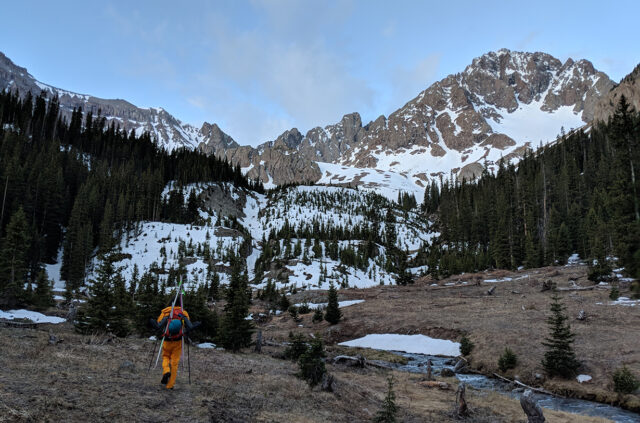
The Cham’s fabric breathes better than almost all other snowsports-oriented shells on the market, but it still fends of wind and moisture better than almost all membrane-less softshells. That’s a really appealing combination for high-output activities like ski touring and splitboarding — especially if you live in an area that rarely sees continuous, heavy, wet snowfall.
Fabric aside, the Cham’s more generous fit is unlike most similarly breathable alternatives, and its feature set is pretty close to perfect (in this reviewer’s opinion) in terms of balancing useful functionality and minimalist weight savings.
Bottom Line
While other folks with different priorities certainly have reasons to opt for something else, personally, the new Strafe Cham Jacket and Pant make for the best all-round, ski-touring outerwear kit I’ve used.

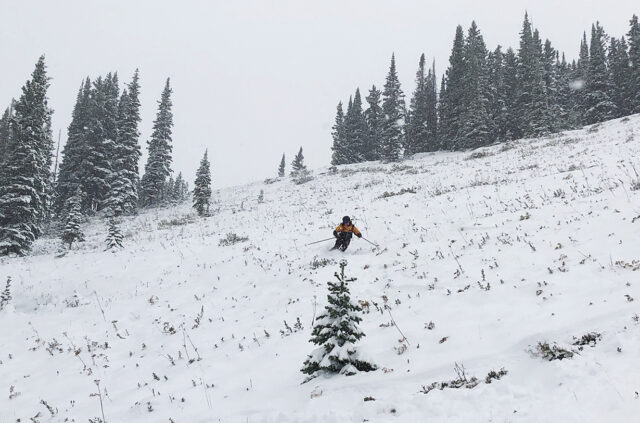



Hey Luke,
Could you please elaborate more about how the breathability of the Cham kit compares to the breathability of the Descencionist kit?
For strictly ski touring in the British Columbia interior (Ex. Kootenay Pass, Whitewater Backcountry, Rossland Range, Rogers Pass) where we have a tendency to get great snow but definitely not as dry as the Rockies, would the breathability/waterproofness ratio of the Cham kit of the Descenionist kit be preferable?
Thanks!
I haven’t yet been able to do any back-to-back testing with those pieces, but I think they’re really similar in terms of breathability, to the point that I don’t think that should be the deciding factor (and the Descensionist is discontinued, which means it might be tricky to find). As for weather resistance, it’s tough to gauge, but I think the Cham is slightly more water resistant, but again, not some night-and-day difference. So far, the Cham’s performance seems pretty ideal for what you’re describing, though if you want notably improved weather resistance in super wet conditions with as little of a tradeoff as possible in terms of breathability, I’d look to eVent pieces like the Eddie Bauer BC Freshline, Flylow Lab Coat, or Strafe Nomad, or Gore-Tex Active pieces like the Patagonia Ascensionist if you want something much lighter and more minimal.
Thanks for your response!
Given that the Descensionist and the Cham are so similar in performance characteristics I think that I will go with the Descensionist kit, because I prefer the ethos of Patagonia. I have been able to track down a Descensionist kit. Additionally I have a heavy Gore Pro kit that I can use in the backcountry if it is very wet. The way that Cy has described the waterproofing of the Descensionist has made it sound totally adequate for what I need it for.
Any issues with the pant leg fitting over mid-weight touring boots while in walk mode? I’ve been running the Tecnica Zero G Tour Pro and have found that when all cuff buckles are open, some touring pants struggle to fit over them. Not an issue on the flats, but once you have to start booting, it can be a pain.
I never had that issue with the Hawx Prime XTD I was using with the pants, which I typically skin / bootpack with the cuff buckles nearly fully open, so I suspect it’d work fine with the Zero G with its buckles open.
How does this breath compared to jackets that use neoshell such as the apoc or older version of the cham?
Unfortunately, the only NeoShell kits I’ve been in recently (Bonfire Apex & the old Strafe Pyramid) use pretty thick face fabrics and aren’t designed to be ultralight like the Cham. That said, I’d say the Cham is slightly more breathable than them. Not a massive difference, and I think a large part of it comes down to the Cham’s more minimal laminate construction, but that’s my take right now.